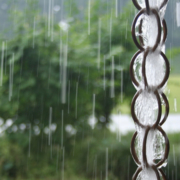Catch the Rain By Slowing and Storing It
If rain gutters are installed on your house, water will be directed into downspouts, where it can move with great force and speed. This is especially true in a large storm. Instead of allowing downspouts to discharge directly on hard surfaces like a driveway, path, or patio, think about ways to redirect downspout water into vegetated landscape areas.
One option is to replace downspouts with “rainchains” to slow down the water so it can be more easily absorbed when it reaches your landscape areas. Add a rain barrel or cistern at the bottom of downspouts or rainchains and let it overflow into the garden.
If rain gutters are not installed, water shears off roof surfaces and can cause erosion damage. Areas under the eaves may be covered in permeable groundcovers such as pea gravel, mulch, or rocks to reduce the compacting force of water falling on bare soil. Spreading fresh leaf and wood chip mulch throughout the garden will slow down water. Healthy soil can withstand even the strongest rain.
Ways of storing rainfall
Rainwater can also be harvested and stored. Storage vessels include rain barrels and cisterns directly connected to downspouts
Stored water can be released gradually into the landscaping between winter rainstorms, building up the soil sponge and ensuring that native plants get adequate water during the winter months when they need it most. If you need water in the summer and capture enough of it during the winter, you may be able to use your cistern water for irrigation
Both rain barrels and above–ground cisterns can be relatively inexpensive to purchase and easy to install. Mosquitos are kept out using screens. With minimum maintenance and common sense, the water can be kept safe. If you plan to store rainwater, make sure the “first flush” is diverted directly into the landscaping before capturing the rainfall that follows.
Properly placed trees also are excellent landscaping features to help capture rainfall, allowing it to be released slowly over time into the soil.
This article was inspired by the 71-page Sustainable Landscapes Program guidebook available at SustainableLandscapesSD.org. The Water Authority and its partners also offer other great resources for landscaping upgrades, including free WaterSmart classes at WaterSmartSD.org.




